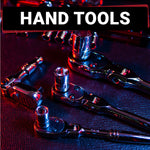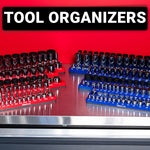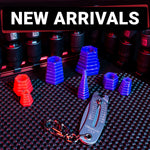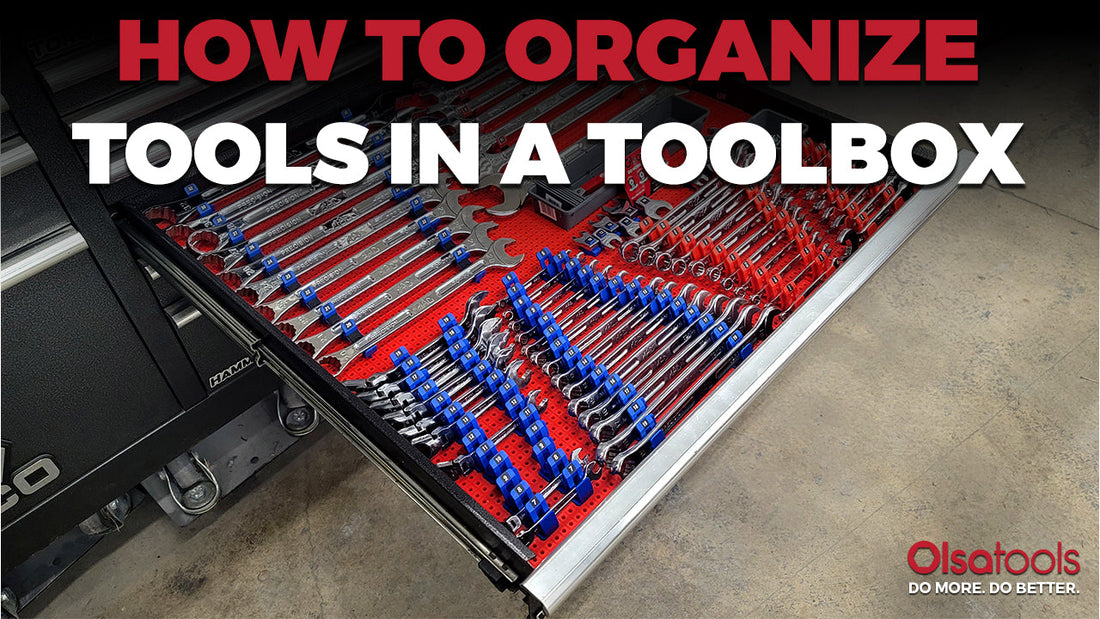Every mechanic understands the frustration of searching for tools in a messy toolbox. This wastes time and can damage your valuable equipment. A well-organized toolbox helps you work faster and protects your investments.
We’ll help you transform your jumbled toolbox into a setup that will impress the pros.
3 Common Toolbox Types for Mechanics
Before diving into organization tips, let's review your main tool storage options. Each type fits different work needs based on your tool collection.
Portable Toolbox
Portable toolboxes work well for mechanics who move between locations. Portable tool organizers come in sizes from small boxes for basic home projects to larger wheeled units for numerous hand tools and accessories.
Tool Bag
Tool bags are extremely portable, with exterior pockets that store frequently used items within reach. Mechanics who use many small hand tools such as screwdrivers, pliers, and wrenches often prefer this option.
The shoulder straps keep your hands free while carrying tools between work areas. When space limits your storage options, bags adapt to awkward storage spaces more readily than rigid toolboxes.
Tool Chest
Tool chests have substantial storage capacity through multiple sliding drawers; a standard for professional mechanics with extensive tool collections. The deeper top sections with hinged lids fit larger items, while drawers organize smaller tools systematically.
Tool chests stay in one place most of the time but organize large collections in a way that keeps everything visible and accessible. You'll find these in professional garages and workshops where mechanics work in a fixed location.
Now that you understand the different toolbox options, let's explore the most effective ways to organize your tools for maximum efficiency and accessibility.
Step 1: Inventory Your Tool Collection
Before organizing your toolbox, take note of what you own. Spread out all your tools on a clean surface and group similar items together. This gives you a clear picture of your collection and helps identify missing or duplicate tools.
Look for:
- Sockets and ratchets
- Wrenches and pliers
- Screwdrivers and bits
- Hammers and mallets
- Measuring tools
- Power tools and accessories
As you sort through your tools, check each for damage or wear. Replace or repair tools that need attention. This way, you’ll eliminate future frustration when you reach for a tool and find it doesn't work properly.
Note which tools you use most often. These high-use items deserve prime spots in your toolbox for quick access during projects.
With an understanding of what you have, you can create storage solutions that fit your needs rather than following a generic approach that might not work for your collection.
Step 2: Categorize Tools by Type and Function
After reviewing your collection, group your tools into logical categories. Put similar tools together to speed up retrieval and save time during projects.
Start with these common categories:
Hand Tools
- Separate wrenches by type: combination, ratcheting, and socket wrenches
- Group screwdrivers by head type: Phillips, flathead, Torx, and hex
- Arrange pliers by function: needle-nose, slip-joint, locking, and cutting
Socket Sets
- Divide by drive size: 1/4", 3/8", and 1/2" drives
- Further sort by standard (SAE) or metric measurements
- Keep deep and shallow sockets in distinct groups
Measurement Tools
- Put calipers, tape measures, and levels together
- Store smaller precision tools in protective cases
Power Tools
- Group drills, impact drivers, and their batteries together
- Store larger power tools with their specific attachments
Fasteners and Small Parts
- Sort screws, nuts, bolts, and washers by size and type
- Use small containers for these items to prevent mixing
For mechanics who work on specific projects regularly, you might create additional categories based on job types, such as brake work tools or electrical repair equipment.
Step 3: Invest in Purpose-Built Organizers
The right organizers transform your chaotic toolbox into an efficient workspace. Purpose-built storage solutions keep tools secure, visible, and protected from damage.
- For socket sets, magnetic socket organizers hold each piece firmly in place. These rails display size markings clearly and prevent sockets from rolling around loose in drawers.
- Wrench organizers come in different styles. Magnetic holders mount easily on metal surfaces and rail systems keep wrenches visible and accessible in size order.
- Screwdriver racks store tools vertically to maximize drawer space. Wall-mounted options free up valuable drawer space for other tools.
- Foam organizers create custom cutouts for each tool. This system makes missing tools immediately apparent and protects expensive equipment from bumping against other items.
- Small parts organizers with divided compartments store fasteners, bits, and other tiny components that otherwise disappear at the bottom of drawers.
Quality organizers might cost more initially but pay dividends through time saved and extended tool life. Olsa Tools offers professional-grade organizing solutions for mechanics that balance affordability with durability.
Step 4: Prioritize Based on Usage Frequency
Not all tools require equal access. Smart toolbox organization puts your most-used tools within easy reach.
Here are some ideas:
- Place the tools you use daily in top drawers or at the front of your toolbox. For many mechanics, this includes ratchets, common socket sizes, and basic hand tools.
- Store specialized and larger tools in lower drawers or back sections. These might include AC service tools, timing belt equipment, or transmission specialty tools that you only need occasionally.
- Middle drawers work well for tools you use weekly but not daily. This tier often includes uncommon wrench sizes, specialty pliers, and diagnostic tools.
As your work patterns change, adjust your organization system. The socket set you once used monthly might become a daily necessity for new projects, so move it to a more accessible location when this happens.
Step 5: Maximize Vertical Space
Most mechanics fail to use the full height inside their toolbox. Smart vertical organization multiplies storage capacity instantly.
Transform a jumbled pile of tools into organized layers with tiered organizers. These create multiple levels within a single drawer, perfect for separating socket trays from lighter tools above them.
Install magnetic strips along the inside lid of your toolbox for storing essential tools you reach for constantly. This converts unused space into practical storage.
For mechanics tools with odd shapes, use drawer dividers that stand upright. These create vertical zones for different tool categories within the same drawer.
Use foam cutouts in drawers that allow tools to stand on end rather than lay flat, increasing how many fit in the same space.
Step 6: Use Labels
Labels turn your organized toolbox into a system that saves time during every project. This simple step prevents confusion and speeds up your workflow.
For effective labeling:
- Mark every drawer with its contents using large, readable text.
- Label socket organizers with size information for a quick selection of basic tools.
- Use color-coding to distinguish between metric and standard selection of tools.
- Apply waterproof labels that resist oil and dirt common in mechanic work.
- Create custom labels for specialty tool collections unique to your work.
- Mark power tool cases with their contents and battery compatibility.
- Update labels whenever you reorganize or add new tools to your collection.
Step 7: Maintain Your System
Even the best system fails when tools end up in the wrong places over time. To keep your organization effective:
- Return each tool to its designated spot immediately after use
- Clean tools before storage to prevent dirt and grime buildup
- Perform weekly quick audits to spot any misplaced items
- Schedule monthly reviews to assess if your system still meets your needs
- Replace worn or damaged organizers before they fail completely
- Adjust your system when you acquire new tools or retire old ones
- Reset completely disorganized areas rather than continuing with a broken system
- Teach others who use your tools about your organization method
The few seconds it takes to put tools back properly saves minutes of searching later. This discipline becomes a habit after consistent practice.
Remember that your organization system serves your work, so if you notice inefficiencies, modify your approach. The perfect system evolves with your changing needs and projects.
Choose Olsa Tools Organizers
Olsa Tools organizers bring order to chaos with professional-grade solutions at affordable prices. Our magnetic socket holders grip tools firmly through bumps and transport. Wrench organizers showcase every tool for instant access. Screwdriver racks maximize space and keep your tools visible.
Built from durable materials that withstand shop conditions, these organizers protect your investment while speeding up your work. Professional mechanics trust Olsa Tools organizers to handle daily use without breaking or losing magnetic strength.
Organize Tools FAQ
Is a pegboard better than a tool chest?
Pegboards, like our Toolgrid system, and tool chests serve different purposes. Pegboards display tools visually on walls, which saves floor space and makes tools accessible at a glance. Tool chests protect tools better and offer organized drawers for sockets and wrenches. Most mechanics use both: pegboards for frequent-use items and chests for valuable or heavy tools.
How do I organize my tools without a toolbox?
Without a toolbox, transform your workspace with strategic zones. Wall-mounted pegboards provide perfect homes for screwdrivers and pliers while keeping them visible. Socket rails attached directly to walls keep socket sets organized and accessible. Keep small parts protected in repurposed containers. For larger items, ceiling hooks maximize space usage. The combination of wall organizers, open shelving, and labeled bins creates a comprehensive system that many DIY mechanics find even more functional than traditional toolboxes.
How do you arrange power tools?
Position power tools near outlets with a central charging hub. Store larger tools on sturdy shelves, with accessories in labeled containers. Keep original cases for specialty tools. Use wall hooks for frequent items. Place air tools near compressors. Store batteries separately in a cool location. Maintain a manual binder for reference.
How do I organize a plethora of tools when space is limited?
Use multi-functional organizers that maximize every inch. Prioritize your common tools in accessible areas and store specialty wrenches and seasonal items in less accessible spaces. Vertical storage systems let you store more in the same footprint. Removable trays create a flexible organization that adapts as your collection grows.
What's the best way to store heavy tools in a toolbox?
Position heavy tools in bottom drawers or lowest shelves of tool storage cabinets to maintain stability. Use storage drawers with ball-bearing slides that support substantial weight.
For power tools like impact wrenches, remove batteries to reduce weight. Create a separate drawer for particularly heavy items rather than mixing them with lighter tools. Foam inserts prevent shifting while protecting against damage.
How should I organize my garage tools by type?
Create zones based on function: hand tools, power tools, and measurement tools. Store cordless tools near charging stations, air tools near compressors, and rotary tools with their accessories. You can also use socket rails for organized socket storage.
A box for wrenches keeps them sorted by size. Get wall-mounted systems for tools you use frequently. Make a careful selection of what stays in toolboxes versus what deserves wall space for quicker access.
What should I do with extra tools that don't fit in my primary toolbox?
Develop a secondary storage system for extra tools using portable carriers with outer pockets for quick access items. Create specialized kits for specific jobs so you can grab exactly what you need. Store backup or duplicate tools in clearly labeled bins.
Create a modular system where each separate tool category has its dedicated storage. For occasional-use specialty tools, wall-mounted tool storage ideas keep them accessible without consuming primary toolbox space.








